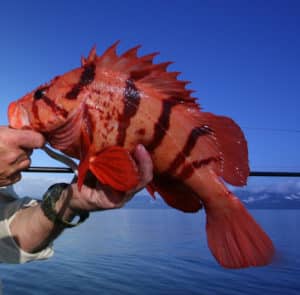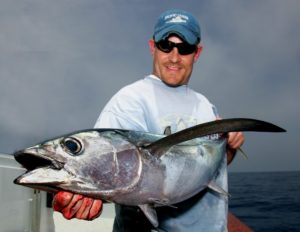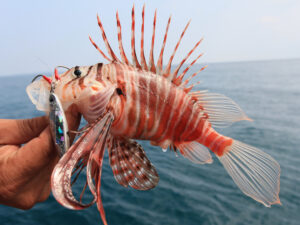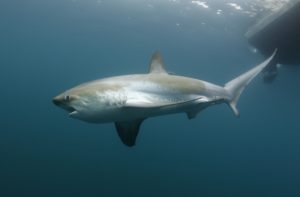Slightly Toxic, Substantially Tasty
QUESTION:
While we were fishing a school of mahi, someone left the jig rod in free spool, and the jig made it to the bottom in a little over 900 feet of water. When I realized it was in free spool, I ran over, put it gear and started cranking. Three or four cranks up, I felt a thump and the rod bent more. After cranking for 10 minutes, I had this bright pink-and-orange big-eyed fish at the surface. It was 12 inches long and about a pound and a half. What is it, Fish Facts?
Jason Arnold
Ft. Lauderdale, Florida
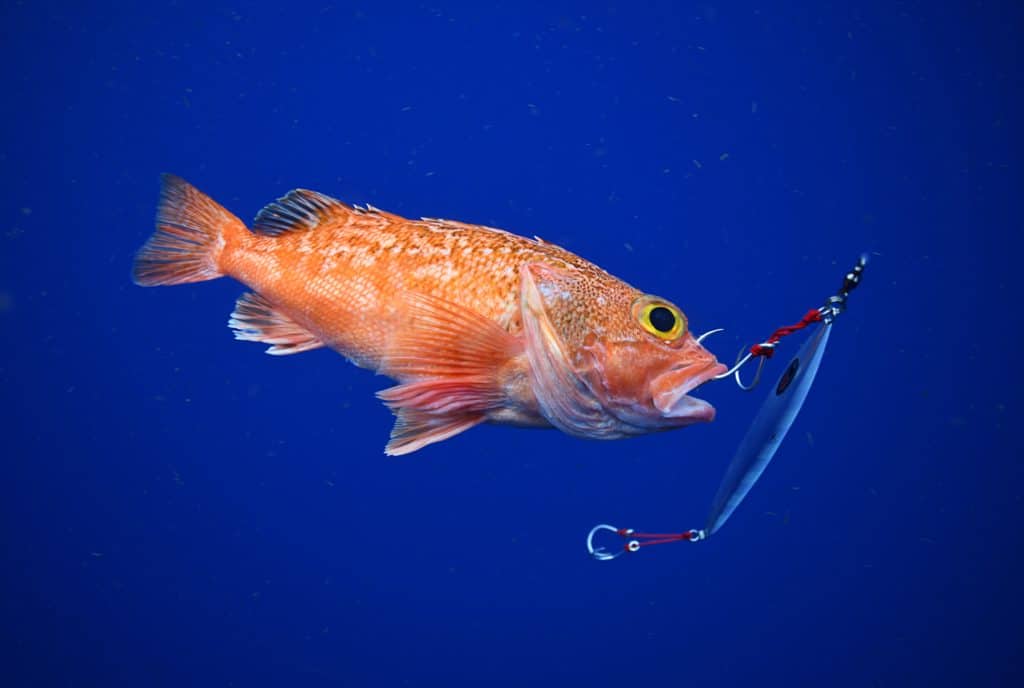
ANSWER:
You caught a blackbelly rosefish, Heliocolenus dactylopterus, Jason – and you took a great photo of it. The long second spine from the top on the fish’s preopercle, along with the relatively smooth head, lacking cirri (small fleshy appendages), help identify this species. The blackbelly rosefish is a deepwater member of the scorpionfish family, Scorpaenidae, inhabiting depths between approximately 250 and 2,400 feet from Maine to Guyana in the western Atlantic. It’s absent from all but the westernmost Bahamas as well as the islands of the Antilles and the Gulf of Mexico; its presence elsewhere in the western central Atlantic is uncertain. It’s also found in some locations in the eastern Atlantic. It grows to more than 5 pounds, witness the all-tackle world-record blackbelly of 5 pounds, 3 ounces, taken off Virginia in 2009. Like other scorpionfishes, the blackbelly rosefish makes fine table fare, although one needs to be careful of the species’ venomous spines when cleaning it. Cutting the tips off the spines with shears or using heat provided by a handheld torch to denature the proteins in the fishes’ venoms are techniques sometimes employed to help make cleaning Scorpaenids safer. Luckily, unless one has a particular sensitivity to the venom, a sting by a blackbelly rosefish won’t be fatal, but can be quite painful.
— Ray Waldner
Lovely Lizard
QUESTION:
I caught this fish in the Gulf of Mexico west of Venice, Florida, in 65 feet of water. It looks part sand perch and part lizardfish, but unlike those fish, has a black dot on each side. The fins are like a sea robin’s. Did I catch a species of fish or a crossbreed of many?
Bob LaBarbera
Nokomis, Florida
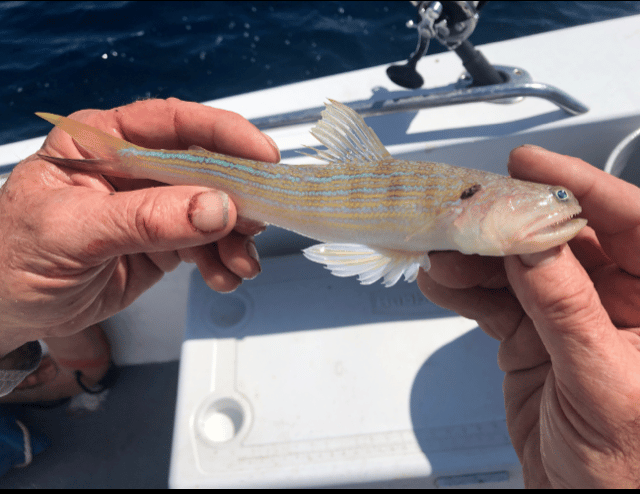
ANSWER:
You’re part right, Bob — the lizardfish part. Your catch is a snakefish, Trachinocephalus myops, which is in the lizardfish family though not as common as the other lizardfishes. These guys remain solitary on sandy bottoms, usually near reefs. They’re talented ambush predators, lying in wait, partially buried in the sand. When unwitting prey passes overhead, the snakefish explodes from the bottom, and that huge mouth with a lining of needle-sharp teeth makes quick work of its victim. Most lizardfishes are pretty drab, but your catch shows how brightly colored snakefish are; maybe that’s why you thought it to be part sand perch. The snakefish is found worldwide in tropical and subtropical seas. It’s a small fish, rarely exceeding a foot in length. And like all family members, it’s considered useless as a food fish.
— Bob Shipp
Life’s a Bowl of Cherry Anthiids
QUESTION:
I caught this anthias in Tokyo Bay last July. Can you tell me more about this species? Is it found elsewhere in Asia, and what about the family to which it belongs?
Steve Wozniak
Alamo, California
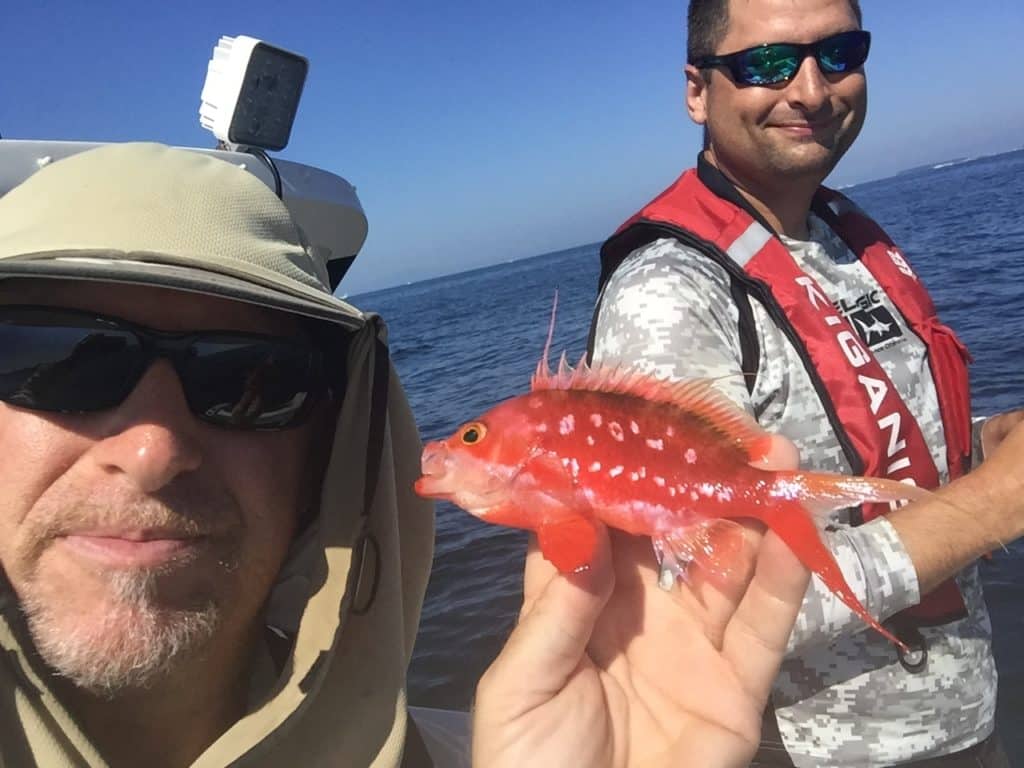
ANSWER:
Steve — That fish is clearly a basslet from the subfamily Anthiinae, a group of small colorful fishes related to the groupers, within the family Serranidae. But the specific identity of this fish perplexed me with the materials I have available on hand, so I enlisted the help of ichthyology expert Jeff Johnson from the Queensland Museum. Jeff informed me that the fish is in fact a cherry anthias, Sacura margaritacea, an apt name for such a pretty species. The color patterns on your fish, with its rich red with white speckles along the upper flanks, confirm it as a male. Females, on the other hand, are a drab orange color with a black blotch on the dorsal fin. This species is restricted in distribution to the northwestern Pacific from Southern Japan to Taiwan, where it’s found mainly near deep dropoffs on offshore rocky reefs between 50 and 150 feet. They feed on smaller fish, crustaceans and other invertebrates. Females of this small species grow to around 4 inches and males max out around 6 inches long to the tail fork (which equates to around 10 inches to the tips of the tail). So your fish is a big boy, at least for a cherry anthias!
— Ben Diggles
Read Next: Strange Fishes From the Deep: Argentinian Sandperch and More
Sport Fishing’s Prestigious International Panel of Experts
Northeast: Mike Fahay, Sandy Hook Marine Lab, New Jersey
Southeast: Ray Waldner, Ph.D., Palm Beach Atlantic University, Florida
Gulf of Mexico: Bob Shipp, Ph.D., University of South Alabama
West Coast: Milton Love, Ph.D., UCSB, California
Far Pacific: Ben Diggles, Ph.D., Queensland, Australia
Bluewater Pelagics: John Graves, Ph.D., Virginia Institute of Marine Science
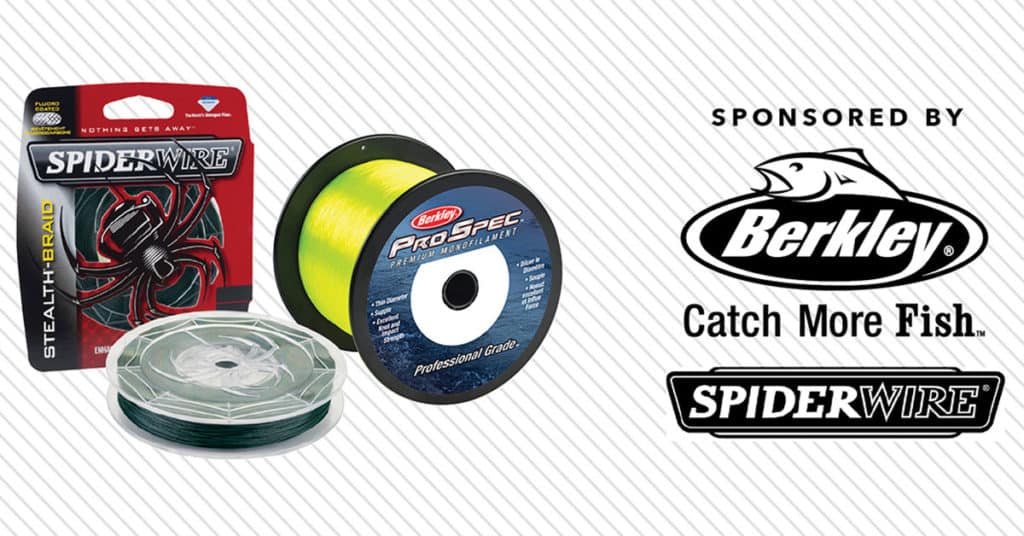
CHALLENGE OUR EXPERTS (And Win Up to 10,800 Yards of Line!)
Send in your question and any relevant photos of your mysterious catch or observation for our experts’ ID and feedback. If we publish your question and you have a shipping address within the United States or Canada, you’ll win a 3‑pound spool of Berkley Pro Spec ocean-blue or fluorescent-yellow monofilament (1,000 to 10,800 yards, depending on line strength) or a 1,500‑yard spool of Spiderwire Stealth braid up to 100‑pound‑test! Send questions and images via email to fishfacts@sportfishing.com (include your hometown) or via post to Sport Fishing Fish Facts, 460 N. Orlando Ave., Suite 200, Winter Park, FL 32789.

